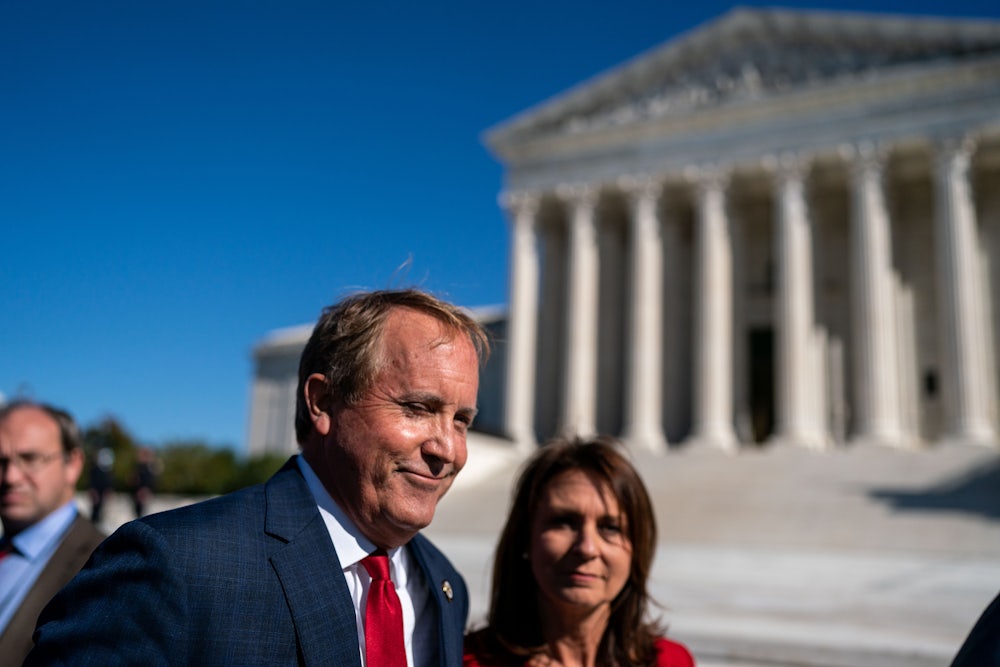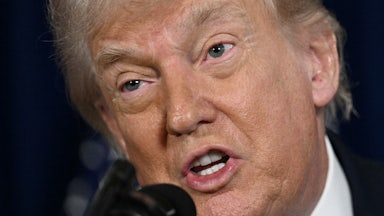There are 94 federal judicial districts in America, but one has become the primary venue of choice for Republicans looking to challenge President Biden’s every move: the Northern District of Texas.
It’s no secret why the party turns to this particular district in search of a favorable ruling. All but two of its 18 judges were appointed by Republican presidents, and a Democratic president hasn’t appointed one in the district since 1999. Almost every major Biden administration initiative runs a similar gauntlet: A coalition of Republican state attorneys general files a legal challenge in the Northern District, a Republican-appointed judge grants a preliminary injunction blocking the policy from going into effect, the majority-Republican-appointed Fifth Circuit Court of Appeals upholds the order, and the majority-Republican-appointed Supreme Court usually declines to intervene.
This practice is known as judge-shopping, and two Northern District judges in particular sit atop Republicans’ wish list: Judge Reed O’Connor, the George W. Bush appointee who gutted the Indian Child Welfare Act and tried to overturn the Affordable Care Act, and Judge Matthew Kacsmaryk, who blocked the Biden administration’s efforts to end the Trump administration’s “Remain in Mexico” program for asylum applicants on the Southern border.
Partisan actors have been able to game the legal system successfully in this way because of a shortage of federal judges in Texas—but Democrats in Congress may be able to do something about it.
Adding more seats to the Supreme Court was, until recently, a taboo topic in American politics. Since Franklin D. Roosevelt’s court-packing plan failed in Congress in 1937, no president has attempted another push to remake the nation’s highest court in their own image. But court expansion is a necessity in the lower federal courts, which regularly need to add new judgeships to match the nation’s ever-growing population. Nowhere is that more important than in Texas, the fastest-growing state in the U.S.
In 2020, the Judicial Conference of the United States, the federal courts’ policymaking body, recommended that Congress add 70 new federal judgeships. Ten of those seats would go to federal district courts in Texas, with six allotted for the Western District, two for the Eastern District, and two for the Southern District. There are good nuts-and-bolts reasons to add more federal judgeships. With fewer judges, cases take longer to process, making it harder for litigants without deep pockets to pursue them.
“Increasing caseloads lead to significant delays in the consideration of cases, especially civil cases, which may take years to get to trial,” Judge Brian Miller, who testified before Congress in 2020 on behalf of the courts, told lawmakers. “Nationally, the average time between filing and trial for a civil case is a little over two years. In many of these overworked courts, the average time between filing and trial is much longer, often three or four years.”
Another good reason would be to curtail judge-shopping. “Some district courts have carefully divided their caseloads to avoid the possibility of judge-shopping—ensuring that no judge hears more than 10–15 percent of the cases filed in any specific division,” Steve Vladeck, a University of Texas law professor, wrote in January. “But others haven’t. Of the seven divisions in the Western District of Texas, four have exactly one judge hearing every single case. And five of the seven divisions in the Northern District of Texas have one judge hearing all or most cases—including the Wichita Falls division, where O’Connor hears more than 85 percent of civil cases.”
Of the 20 lawsuits filed against the Biden administration by Texas Attorney General Ken Paxton, 13 were filed in district court divisions with only a single judge, all of whom were Trump appointees. Last September, for instance, Paxton filed a legal challenge to the Equal Employment Opportunity Commission’s guidance for gender identity and workplace discrimination in the Amarillo Division of the Northern District. By filing there, he effectively ensured that it would be heard by Kacsmaryk, who staunchly opposed anti-discrimination protections for gay and transgender Americans in his pre-judicial career. Kacsmaryk came under intense criticism during his confirmation process for previously describing homosexuality as “disordered” and signed a letter in 2016 that described being transgender as “a delusion.”
The partisan valence of these cases makes them a particularly good example of the problem. But high-profile cases aren’t the only places where Texas’s dearth of federal judges is causing headaches. Consider the plight of Judge Alan Albright, a federal district court judge in the Western District of Texas. Former President Donald Trump nominated Albright for the position in 2018, and the Senate confirmed him in a voice vote that same year. He joined the bench after a private-practice career where he focused on patent-related cases. Since his confirmation, the Western District has become a hub of patent-related litigation, as lawyers from across the country seek out his apparent expertise and wisdom in such disputes.
“Since [Albright] took the bench, more than 1,400 patent cases have been filed in Waco—far more than the division received in its prior thirty-five years of existence,” J. Jonas Anderson and Paul R. Gugliuzza, two law professors who scrutinized the phenomenon, wrote in a Duke Law Review article last year. They also noted that his district became a haven for a particularly pernicious type of patent litigant: the so-called “non-practicing entity,” or NPE, which is the neutral term for a person or company that owns a patent but does not actually use it. They are more commonly described as “patent trolls” for allegedly misusing the legal system.
Albright played no small role in drawing such cases to him. Almost immediately after his confirmation, he began appearing at conferences and bar association meetings to discuss why patent lawyers should file cases in his district. “Most colorfully, he gave a presentation at the 2019 annual meeting of the American Intellectual Property Law Association titled, ‘Why You Should File Your Next Patent Case Across the Street From the “Hey Sugar,’’’ referring to a candy store near his Waco courthouse,” Anderson and Gugliuzza wrote. Since Albright is the only judge assigned to the Waco Division, plaintiffs can guarantee that he will be the one to hear their case if they file it in that division. Toward the end of 2021, nearly 900 patent-related cases had been assigned to Albright, amounting to roughly 25 percent of all patent cases in the entire nation.
“We believe this creates an appearance of impropriety which damages the federal judiciary’s reputation for the fair and equal administration of the law,” Democratic Senator Patrick Leahy and Republican Senator Thom Tillis wrote in a letter on Albright’s actions to Chief Justice John Roberts last November, which was addressed in his capacity as the Judicial Conference’s presiding officer. “Worse still, such behavior by plaintiffs can lead individual judges to engage in inappropriate conduct intended to attract and retain certain types of cases and litigants.” Roberts, writing in his year-end report on the federal courts last December, said the conference would be looking into the matter further. The Federal Circuit Court of Appeals, which handles appeals for patent cases, also castigated Albright last fall for refusing to transfer cases to jurisdictions that are more convenient for the litigants.
Legal scholars have proposed a few procedural tweaks that could go a long way toward addressing this issue. Anderson and Gugliuzza suggested that the courts could require that each case have no more than a 50 percent chance of being assigned to a specific judge, or that Congress could further clarify that patent law cases should only be filed in venues, including divisions, where the parties have clear connections. Vladeck echoed the 50 percent requirement and suggested that courts also require that no more than one-third of a division’s cases be assigned to a particular judge.
These are good technical recommendations that would help alleviate the problem. An even more efficient way to prevent litigants from getting their cases before specific judges in Texas would be simply to create more federal judgeships in Texas. Congress can accomplish this through normal legislation, which may require overcoming the filibuster. Considering Texas’s explosive growth over the past decade, Congress should feel comfortable adding even more district court judgeships than the Judicial Conference recommended to ensure the district courts in the Lone Star State can keep up with the state’s population. Everything’s bigger in Texas, they like to say, and that should apply to the size of its federal bench, as well.








